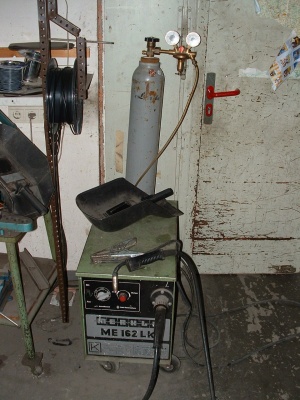Welding machine
Write about your welding machine here to help other builders !
Contents
Lincoln 3200 MIG wirefeed
Price $180US Hobby level MIG (same as MAG) welder. Has fan cooling and is reliable for a bike project. It can weld steel only. I thought with the spool gun add-on ($160US) it can weld aluminum but no, for that you will need a more expensive model (about $350 and 240V). The 3200 needs only 115V AC and welds from 1.5mm to 5mm thick. Use a Argon/CO2 mix. I am not a world class welder but this works well for me. Not for everyday continuous use (get a 230V model instead for that, and make sure it can weld aluminum!).
This entry was edited since I found out the welder I bought could not be fitted with a wire feed spool gun, necessary for aluminum wire feeding.
Cheap electric welder from DIY-Market (Praktiker): "T.I.P."
Price: 30 € (new)
power adjustable in 3 steps
no fan cooling
Not recommendable
Omicron Gama 166 electrode/TIG DC welder
Price 6000 CZK (about 250 €)
Input 230 V AC, output 10..95 A DC (or up to 160 with pauses)
Professional level small inverter. Very light (5 kg) and easily portable. Standard electrode holder is included, TIG handle isn't. Compared to cheap AC transformers, the arc is smoother and much easier to start and handle, mainly due to the "hot start" function (automatic use of higher power for starting). There is also an "antistick" function, but it's actually just reduction of current if the electrode does stick. With low power settings (30 A or so), it can weld quite thin steel too, 1 mm seems plausible even with electrodes. And then there is the TIG option...
Overall, I'm quite happy with it. --Mirek 19:37, 2 May 2012 (CEST)
MAG Welding Machine with Autofeed
This welding machine is about 20 years old and did a great job in all these years. The CO2 bottle lasts for ages and the wire spool of the automatic feeder lasts for several ages. The machine has a power supply of 230 V. Welding steel sheets and tubes of thickness from 3.7 downto 1.0 mm is possible. The machine is not suitable for welding thinner sheets and tubes. Very recommendable for beginners because of its easy handling! MAG welded pieces don't have to be postprocessed in any way because the welds are metallic bright and not oxidized. Also the preparation of the parts does not have to be very accurate as gaps of upto 5 mm can be bridged. However all coatings of paint, rust and electroplated stuff, especially chromium and zinc have to be neatly remove before the welding!
The pictured machine is almost famous by its own: The first prototypes of ZOX bikes have been created with it as well as no less than eight pythons. --Jürgen 10:33, 17 February 2011 (CET)
Flux-core welders
(for low-budget / beginning builders)
Chicago Electric 90 Amp Flux Wire Welder
~$100 at Harbor Freight when on sale + 20% coupon
Input: 120 volts, 20 amps, single phase, 60 Hz, much easier to set up than 220 volts + gas tank
Duty Cycle: 45% @ 60 amps, 25% @ 80 amps, lower power setting would be nice for thin wall tubings
Wire capacity: 0.030"/0.035" flux core wire, avoid the same brand wire (lot of splatter). Lincoln NR211 MP .030 1LB SP is really nice to work with but it runs out too quickly. Next spool size is 10-lb but requires modification (a project); 2-lb spool is max the welder can handle. Hobart H222106-RTP 0.030-Inch 2-Pound twin pack is a close second choice.
DarkSilverR53 04:18, 3 June 2011 (CEST)
TIG vs. MIG
(advanced / professional level)
Here is a good reference video of a steel trike frame welded with MIG, TIG, and brazing for different types of joints.
part 1, see greenspeed.com sticker at 1:40
part 2 see TIG vs. MIG comparison @ 4:50, brazing @ after 7:30
DarkSilverR53 04:18, 3 June 2011 (CEST)
Brazing vs. Welding
(philosophical)
TIG / MIG is more practical, low to mid-end mass production
Brazing is more "artistic", high-end fillet joints
DarkSilverR53 04:18, 3 June 2011 (CEST)
